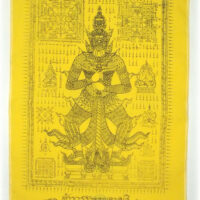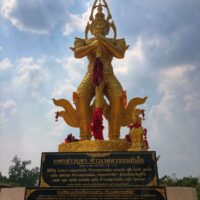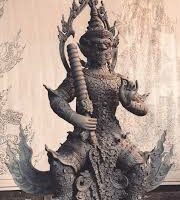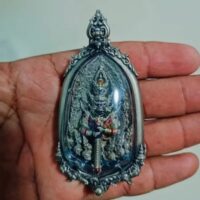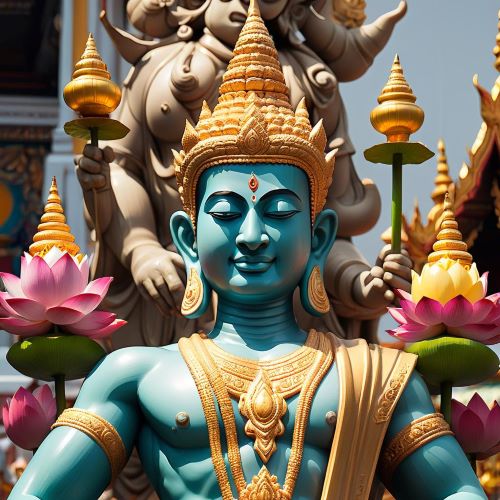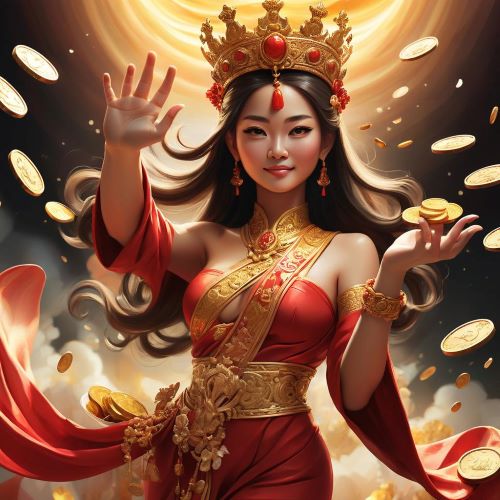
Thao Wessuwan : The Guardian of Wealth
Listen
At a glance
| Description | |
|---|---|
| Origin | Thai Mythology |
| Classification | Gods |
| Family Members | Bhunjati (Wife), Lata, Sajja, Pavara, Acchimati, and Suta (Daughters) |
| Region | Thailand |
| Associated With | Wealth, Protection |
Thao Wessuwan
Introduction
Thao Wessuwan, revered across Thai and broader Buddhist cosmology, stands as a commanding figure of divine authority, wealth, and spiritual protection. Often equated with Vessavaṇa in Pali and Kubera in Hindu lore, he is one of the Four Heavenly Kings, tasked with guarding the northern direction of the world. As a sovereign of the yakshas—beings known for guarding natural treasures—Thao Wessuwan’s influence is not only mythological but also deeply embedded in Thai rituals and temple culture. His mythology represents a fusion of spiritual strength and material abundance, often sought by devotees for security and fortune.
Physical Traits
Thao Wessuwan’s visual portrayal communicates his role as both protector and enforcer. Towering in form, he is usually illustrated as a giant clad in celestial armor, signifying his elevated status among divine beings. His facial expression is intense—often wrathful or vigilant—intended to repel evil forces. A defining feature is the heavy spiked club or “grabong” he carries, a weapon symbolizing dominance over malevolent entities.
His skin tone in statues and murals varies, often seen in shades of green or gold. Thai and Tibetan representations might include other symbolic elements such as parasols, snow lions, or elaborate headgear. Every detail in his depiction serves to reflect an aura of majesty and command, reinforcing his position as both a guardian and dispenser of blessings.
Family
While not central to his worship, Thao Wessuwan’s family adds depth to his narrative. According to Buddhist scriptures, his consort is Bhuñjatī, and together they have five daughters—each representing aspects of his legacy. Their names—Latā, Sajjā, Pavarā, Acchimatī, and Sutā—suggest divine elegance and purity.
In some Southeast Asian interpretations, his lineage connects with characters from epic literature. Thai adaptations, for instance, portray him as the son of Thao Lustian and Srisumontha. He also has familial ties with Puṇṇaka, a yaksha known from Buddhist stories, who marries the nāga princess Irandatī. These relationships place him within a wider web of divine and semi-divine beings across the mythological landscape.
Other names
Thao Wessuwan is recognized by various names depending on language, tradition, and regional interpretation. In Theravāda texts, he is called Vessavaṇa, while Vaiśravaṇa is the corresponding Sanskrit term. These names all trace their roots to the term “Vishrava,” his divine ancestor in Hindu mythology, linking him with Kubera, the god of wealth.
In East Asia, he is known by titles reflecting his spiritual responsibilities: Duōwén Tiānwáng (Chinese), meaning “Heavenly King Who Hears Much,” and Tamonten (Japanese), referencing his vigilance and ability to listen to the teachings of the Buddha. Tibetans revere him as Namthöse, and Mongolians as Bayan Namsrai. In Southeast Asia, alternate versions like Thao Kuwen, Tanesworn, and Yanksaraja also exist. These names reflect not only linguistic variation but also the diverse cultural lenses through which his character is viewed.
Powers and Abilities
As a divine protector, Thao Wessuwan’s powers extend far beyond earthly comprehension. Chief among them is his unparalleled ability to dispel evil forces—ranging from spirits to curses—making him a staple in spiritual cleansing rituals. In Thai belief, he commands ghostly legions and works closely with beings like Yommathood (the Reaper) to maintain cosmic balance and uphold karmic justice.
His dominion over treasure and prosperity positions him as a deity frequently invoked for wealth accumulation, success in business, and relief from poverty. Moreover, he serves as a guardian of the Dharma—the Buddha’s teachings—ensuring their preservation and propagation across the mortal realm. His spiritual utility extends to being a grantor of boons, especially for those who engage in merit-making and paritta chanting using the Āṭānāṭiya verses, which he himself delivered to the Buddha.
Modern Day Influence
Thao Wessuwan continues to hold sway over both the religious and cultural imaginations of contemporary Thailand. His statues are commonly placed at the entrances of temples, believed to guard sacred spaces from harm and ensure spiritual safety for monks and laypeople alike. His presence is particularly strong at Wat Chulamanee in Samut Songkhram, where a large shrine has become a pilgrimage site.
In modern spirituality, his image is popular among collectors and devotees of Thai amulets. These sacred objects, often worn around the neck, are believed to bestow protection from ghosts, black magic, and misfortune. Some modern renditions of these amulets combine traditional aesthetics with comic-inspired artistry, appealing to a new generation while retaining ritual potency.
Beyond Thailand, Thao Wessuwan’s various incarnations influence pop culture. In Japan, Bishamonten appears in anime such as Noragami and video games like Record of Ragnarok and Touhou Project, where his treasure-guarding and combat attributes are given narrative form. Even civic identity is influenced; Udon Thani Province features Thao Wessuwan in its provincial seal, a nod to his traditional role as guardian of the north.
Related Images
Source
Antique Buddhas. (n.d.). Thao Wessuwan is the Lord of the Giants #CA1072. Retrieved from http://www.antiquebuddhas.com/ca1072.html
Bangkok Post. (2022, November 15). Of myths and legends. https://www.bangkokpost.com/life/arts-and-entertainment/2438037/of-myths-and-legends
Chulalongkorn University. (2024, April 26). Understanding the Function of Black Magic. https://www.chula.ac.th/en/highlight/156762/
Ekkarat Thai Amulets. (2020, December 9). Thao Wessuwan. https://www.ekthaiamulets.com/post/muaythai-amulets-3
oldthaiamulets.com. (n.d.). Thao Wessuwan 护法鬼王 is a deity in Buddhist mythology. Retrieved from https://oldthaiamulets.com/product-tag/thao-wessuwan-%E6%8A%A4%E6%B3%95%E9%AC%BC%E7%8E%8B/?srsltid=AfmBOooaVoN7TV4EQHIkpZVhbjAN88I7hcb0gjELmHhNS2zPWhfv9xRm
Wikipedia. (2004, March 25). Vaiśravaṇa. https://en.wikipedia.org/wiki/Vai%C5%9Brava%E1%B9%87a
Frequently Asked Questions
What is lorem Ipsum?
I am text block. Click edit button to change this text. Lorem ipsum dolor sit amet, consectetur adipiscing elit. Ut elit tellus, luctus nec ullamcorper mattis, pulvinar dapibus leo.
What is lorem Ipsum?
I am text block. Click edit button to change this text. Lorem ipsum dolor sit amet, consectetur adipiscing elit. Ut elit tellus, luctus nec ullamcorper mattis, pulvinar dapibus leo.
What is lorem Ipsum?
I am text block. Click edit button to change this text. Lorem ipsum dolor sit amet, consectetur adipiscing elit. Ut elit tellus, luctus nec ullamcorper mattis, pulvinar dapibus leo.
What is lorem Ipsum?
I am text block. Click edit button to change this text. Lorem ipsum dolor sit amet, consectetur adipiscing elit. Ut elit tellus, luctus nec ullamcorper mattis, pulvinar dapibus leo.
What is lorem Ipsum?
I am text block. Click edit button to change this text. Lorem ipsum dolor sit amet, consectetur adipiscing elit. Ut elit tellus, luctus nec ullamcorper mattis, pulvinar dapibus leo.



